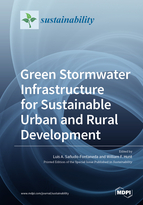Green Stormwater Infrastructure for Sustainable Urban and Rural Development
A special issue of Sustainability (ISSN 2071-1050).
Deadline for manuscript submissions: closed (28 February 2019) | Viewed by 75805
Special Issue Editors
Interests: ancient stormwater engineering; civil engineering heritage; green stormwater infrastructure; highway engineering; low-impact development; sustainable drainage systems; stormwater control measures; sustainable construction; teaching innovation; urban and territorial planning; water-sensitive urban design
Special Issues, Collections and Topics in MDPI journals
Interests: Stormwater Management; Small Catchment Hydrology; Sustainable Drainage Systems; Green Infrastructure; Low Impact Development; Ecosystem Service Provision; Historical Context of Engineering; Water Quality, Ecology; Ecological Engineering; Natural Baselines; Basketball
Special Issue Information
Dear Colleagues,
Human settlements, both in urban and rural environments, are fragile and susceptible to the impact of climate change which threatens the stability of communities across the globe. Rapid and, very often, non-controlled urbanization has increased the risk for flooding by impeding an ordinary natural water cycle. Moreover, urban streams carry more pollution to receiving waters and are at greater risk of degradation. Sustainable stormwater management is part of a strategic plan to achieve resilience against unpredictable changes such as flood and drought conditions. Green Stormwater Infrastructure (GSI) has become one of the main means for adapting urban, suburban, peri-urban and transportation corridors to climate change and minimize the effects of unchecked urbanization; additionally, GSI delivers ecosystem services such as carbon sequestration, heat island mitigation, air quality protection, and increased biodiversity. A good example of the implementation of GSI are the Green Street programmes and Green Highways initiatives, both of which have been developed in many countries worldwide. This Special Issue aims to increase the knowledge in how GSI can (1) impact design and retrofitting activities in urban(izing) regions, (2) meet regulatory requirements, while considering climate change, and (3) provide wider benefits such as biodiversity enhancement, amenity and improvement of flood resilience and pollutant removal efficiency.
Dr. Luis A. Sañudo-Fontaneda
Prof. Dr. William F. Hunt
Guest Editors
Manuscript Submission Information
Manuscripts should be submitted online at www.mdpi.com by registering and logging in to this website. Once you are registered, click here to go to the submission form. Manuscripts can be submitted until the deadline. All submissions that pass pre-check are peer-reviewed. Accepted papers will be published continuously in the journal (as soon as accepted) and will be listed together on the special issue website. Research articles, review articles as well as short communications are invited. For planned papers, a title and short abstract (about 100 words) can be sent to the Editorial Office for announcement on this website.
Submitted manuscripts should not have been published previously, nor be under consideration for publication elsewhere (except conference proceedings papers). All manuscripts are thoroughly refereed through a single-blind peer-review process. A guide for authors and other relevant information for submission of manuscripts is available on the Instructions for Authors page. Sustainability is an international peer-reviewed open access semimonthly journal published by MDPI.
Please visit the Instructions for Authors page before submitting a manuscript. The Article Processing Charge (APC) for publication in this open access journal is 2400 CHF (Swiss Francs). Submitted papers should be well formatted and use good English. Authors may use MDPI's English editing service prior to publication or during author revisions.
Keywords
- Bioretention
- Climate resiliency
- Flood Risk
- Ecosystem Service provision
- Green Infrastructure
- Green Streets
- Maintenance of stormwater infrastructure
- Low Impact Development (LID)
- Participatory methods research
- Planning and Policies
- Policies to confer resilience
- Processes of Adaptation to Climate Change
- Rainwater Harvesting Techniques
- Renewable Energy
- Resilient Food and Water Systems
- Sponge Cities
- Stormwater Management Techniques
- Sustainable Drainage Systems (SuDS)
- Urban Drainage Retrofits
- Water Sensitive Urban Design (WSUD)







